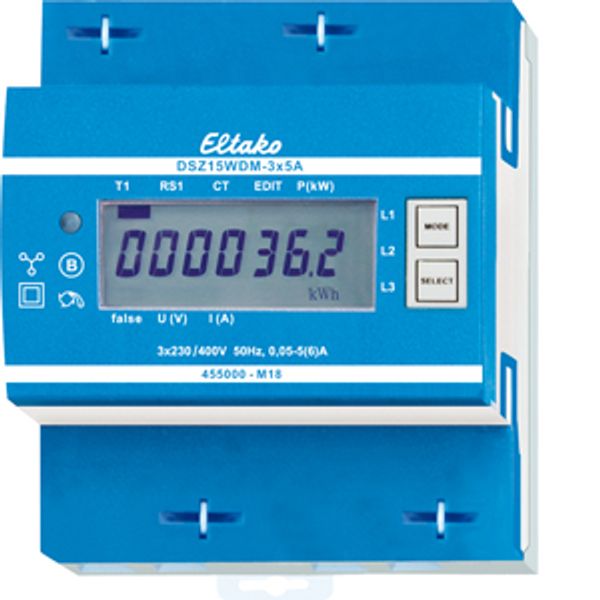Register to unlock your exclusive B2B prices and start shopping. Sign up now!
CT operated three-phase energy meter, MID approval
In stock: No
Vendor stock: No
Minimal order quantity: 1
Price (excl. VAT):
192,25 €
EAN: 4010312501665
MPN: 28305515
Package: 1
Technical Information
| Item condition | New |
| Manufacture name | CT operated three-phase energy meter, MID approval |
| Brand | ELTAKO |
| Categories |
Electric meters
|
| Country of origin | CN |
| Harmonized System Code | 9028 3019 00 |
| Mounting method | DRA (DIN-rail adapter) |
| Width | 70 mm |
| Height | 82 mm |
| Depth | 58 mm |
| Frequency | 50 Hz |
| Max. current (Imax) | 6 A |
| Width in number of modular spacings | 4 |
| Degree of protection (IP) | IP20 |
| Pole type | Four conductor |
| Nominal voltage (Un) N-L | 230 V |
| Nominal current (In) | 5 A |
Packing details
| Packing level 1 | 4010312501665, 4010312501665 |
| Packing level 2 | 4010312501665 |
Other Technical data
| Model | Measurement transformer |
| Suitable for | Purchase |
| Type of indication | Digital |
| Number of positions total (counter) | 7 |
| Type of meter | Electronic |
| Type of interface | M-bus (wired) |
| Energy type | Effective power |
| Tariff type | One-tariff |
| Escapement mechanism | Yes |
| Calibrated | Yes |
| Approval | Measuring Instruments Directive |
| Pulse output | Electrical |
| Accuracy class | B |
| Measurement type load profile | - |
| EEC40 signature | - |
| With lock code | - |
| Nominal voltage (Un) L-L | 400 V |
Downloads
Description
M-bus CT operated three-phase energy meter with settable CT ratio and MID. Maximum current 3x5A. Standby loss 0.5 watt per path only. Modular device for DIN-EN 60715 TH35 rail mounting. 4 modules = 70mm wide and 58mm deep. Accuracy class B (1%). With M-bus interface. This three-phase meter measures active energy by means of the currents flowing between inputs and outputs. The internal power consumption of 0.5 watt active power per path is neither metered nor indicated. 1, 2 or 3 converters with secondary currents of up to 5A can be connected. The inrush current is 1OmA. The N terminal must always be connected. The 7 segment LC display is also legible twice within a period of 2 weeks without power supply. Power consumption is indicated by an LED flashing at a rate of 10 times per KWh. On the right next to the display are the MODE and SELECT buttons to browse through the menu. First the background lighting switches on. Then the total active energy, the active energy of the resettable memory and the instantaneous values of power, voltage and current are displayed for each outer conductor. The CT ratio can also be set. It is set to 5:5 at the factory and blocked with a bridge over the terminals which are marked with JUMPER. To adjust the CT ratio to the installed transformer remove the bridge and reset the energy meter according to the operation manual. Then block it again with the bridge. Adjustable current transformer ratios: 5:5, 50:5, 100:5, 150:5, 200:5, 250:5, 300:5, 400:5, 500:5, 600:5, 750:5, 1000:5, 1250:5 and 1500:5. Error message (false): If there is no outer conductor of the current direction is incorrect, false and the related outer conductor are indicated in the display. M-bus data transfer: On read-out all values are transferred in a telegram. The following telegrams are supported: - Initialisation: SND_NKE, Reply: ACK. - Read out meter: REQ_UD2, Reply: RSP_UD. - Change primary address: SND_UD, Reply: ACK. - Reset RS1: SND_UD, Reply: ACK. - Slave selection for the secondary address, Reply: ACK. The device does not reply to unknown requests. The transfer rate is detected automatically. The device has a voltage monitor. In case of voltage loss, all registers are saved in the EEPROM. Changing the M-bus primary address: To change the M-bus primary address, hold down SELECT for 3 s. In the menu that appears, press MODE to increment the address by 10. Press SELECT to increment by 1. When the required primary address is set, wait until the main menu reappears. Secondary address: It is possible to communicate with the energy meters according to the standard EN13757 using the secondary address. The use of wild cards is possible. For details refer to the operating instructions at www.eltako.com. Important! Before working on the current transformers disconnect the voltage paths of the energy meters.

